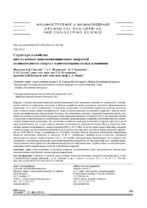Структура и свойства многослойных нанокомпозиционных покрытий поливинилового спирта с наночастицами оксида алюминия

Authors
Date
2023Publisher
Another Title
Structure and Properties of Multilayer Nanocomposite Coatings of Polyvinyl Alcohol with Aluminum Oxide Nanoparticles
Bibliographic entry
Структура и свойства многослойных нанокомпозиционных покрытий поливинилового спирта с наночастицами оксида алюминия = Structure and Properties of Multilayer Nanocomposite Coatings of Polyvinyl Alcohol with Aluminum Oxide Nanoparticles / Д. В. Сапсалёв [и др.] // Наука и техника. – 2023. – № 5. – С. 359-366.
Abstract
Создание нанокомпозиционных полимер-неорганических материалов, изучение их морфологии и механических свойств на наноуровне актуальны в области разработки новых материалов различного функционального назначения, в том числе медицинского. В результате проведенных исследований разработана методика получения одно- и многослойных пленок поливинилового спирта и композиционных полимерных покрытий с наночастицами оксида алюминия методом спин-коатинга. Показано, что оптимальное массовое содержание наночастиц оксида алюминия в суспензии для получения однородных композиционных покрытий составляет 0,625 %. На основании данных о структурно-морфологических и механических свойствах сформированных покрытий, полученных методом атомно-силовой микроскопии, установлено, что увеличение количества слоев композиционных покрытий приводит к росту числа конгломератов, что, в свою очередь, повышает шероховатость поверхности пленок. Модуль упругости однослойных пленок поливинилового спирта составляет (509,5 +- 10 %) МПа. В случае пленок композиционных покрытий с наночастицами оксида алюминия изменения модуля упругости установлены для многослойных покрытий: увеличение до 559,0 МПа (5 слоев) и уменьшение до 415,2 МПа (10 слоев). Модуль упругости исследуемых однослойных покрытий значительно снижается в диапазоне 20−40 ºС. Наименьшие значения после воздействия температур определены для пленок с наночастицами (236,2 +- 10 %) МПа. Нанокомпозиты демонстрируют рост краевого угла смачивания с увеличением количества слоев композиционных покрытий до 20. Последующий рост толщины покрытий (количества слоев) приводит к увеличению гидрофильности нанокомпозитов. Разработанные составы нанокомпозиционных пленок перспективны в качестве сорбционных покрытий.
Abstract in another language
The nanocomposite polymer – inorganic materials formation, the study of their morphology and mechanical properties at the nanolevel is acute in the development of new materials for various functional purposes, including medical ones. As a result of the research the technique for producing single- and multilayer films of polyvinyl alcohol and composite polymer coatings with aluminum oxide nanoparticles by the spin coating method has been developed. It is shown that the optimal mass content of aluminum oxide nanoparticles in suspension for the formation of uniform composite coatings is 0.625 %. Based on experimental data on the structuralmorphological and mechanical properties of the formed coatings obtained by atomic force microscopy, it has been found that an increase in the number of layers of composite coatings leads to an increase in the number of conglomerates which, in turn, increases the surface roughness of the films. The modulus of elasticity of single-layer films of polyvinyl alcohol is (509.5 +- 10 %) MPa. In the case of composite coatings with aluminum oxide nanoparticles, changes in the elastic modulus have been established for multilayer coatings: an increase to 559.0 MPa (5 layers) and a decrease to 415.2 MPa (10 layers). The modulus of elasticity of the investigated single-layer coatings is significantly reduced in the range of 20−40 ºС. The smallest values after exposure to temperatures have been determined for films with nanoparticles (236.2 +- 10 %) MPa. Nanocomposites demonstrate an increase in the contact angle with an increase in the number of layers of composite coatings up to 20. A subsequent increase in the thickness of the coatings (the number of layers) leads to an increase in the hydrophilicity of the nanocomposites. The developed compositions of nanocomposite films are promising as sorption coatings.
View/
Collections
- № 5[10]
